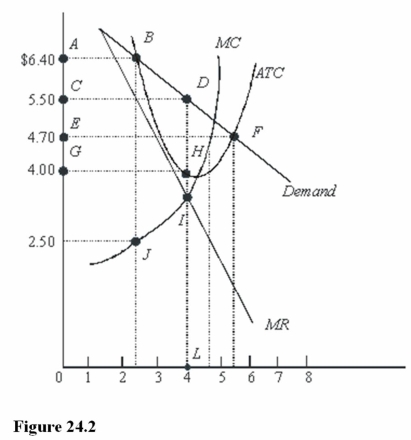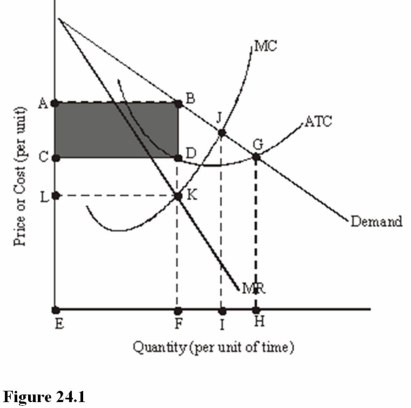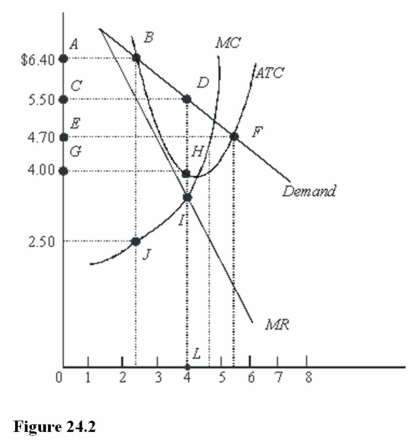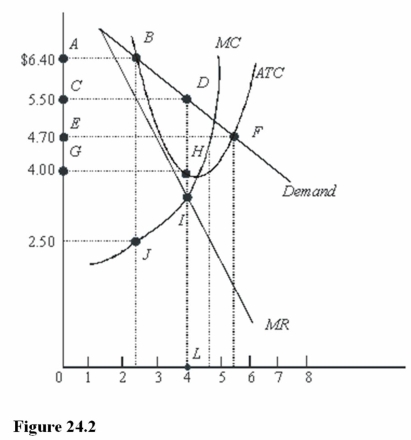A) Maximizes profits at the output level where P = MC.
B) Is one of many sellers in a given market.
C) Charges higher prices than competitive firms,ceteris paribus.
Correct Answer

verified
Correct Answer
verified
Multiple Choice
The marginal revenue curve is below the demand curve
A) If a firm must lower its price to sell additional output.
B) For a competitive firm.
C) When a market is characterized by economies of scale.
Correct Answer

verified
Correct Answer
verified
Multiple Choice
The In the News article "XM-Sirius Merger Made Simple: One Is Always Less Than Two" discusses the proposed merger of two satellite radio companies.Antitrust officials will examine the merger in order to
A) Prevent the abuse of market power.
B) Prevent economies of scale.
C) Protect the government from frivolous lawsuits.
Correct Answer

verified
Correct Answer
verified
Multiple Choice
A monopoly
A) Maximizes profits at the output level where MR > MC.
B) Produces less output than a competitive industry,ceteris paribus.
C) Charges the same price as a competitive industry,ceteris paribus.
Correct Answer

verified
Correct Answer
verified
Multiple Choice
Which of the following is a barrier to entry into a monopoly market?
A) Economic profits for the monopolist.
B) Economies of scale.
C) A large number of firms in the industry.
Correct Answer

verified
Correct Answer
verified
Multiple Choice
A monopolist has market power because it
A) Faces a downward-sloping demand curve for its own output.
B) Can raise price as much as it wishes and not lose any customers.
C) Is a price taker.
Correct Answer

verified
Correct Answer
verified
Multiple Choice
Sky-High Skywriters charges competitive prices for its skywriting services even though it has no competition.This is most likely because
A) There are no economies of scale in this industry.
B) It operates in a contestable market.
C) It is a natural monopoly.
Correct Answer

verified
Correct Answer
verified
Multiple Choice
 -In Figure 24.2,the profit-maximizing level of output is
-In Figure 24.2,the profit-maximizing level of output is
A) Between 2 and 3 units.
B) Between 4 and 5 units.
C) 4 units.
Correct Answer

verified
Correct Answer
verified
Multiple Choice
Price-discriminating firms charge higher prices to those who
A) Have greater incomes.
B) Have lower price elasticities of demand.
C) Have many substitutes available to them.
Correct Answer

verified
Correct Answer
verified
Multiple Choice
According to the text,a convincing argument against concentration of market power is that
A) Market power increases incentives for innovation and invention.
B) Market power results in lower barriers to entry.
C) The exercise of market power results in a higher price.
Correct Answer

verified
Correct Answer
verified
Multiple Choice
If the entire output of a market is produced by a single seller,the firm
A) Is a monopoly.
B) Faces perfectly inelastic demand.
C) Can charge any price it wants and not lose customers.
Correct Answer

verified
Correct Answer
verified
Multiple Choice
All of the following are limitations on the market power of a monopoly except
A) The elasticity of demand.
B) The ability of a firm to control demand.
C) The ability of a company to control the quantity supplied.
Correct Answer

verified
Correct Answer
verified
Multiple Choice
The marginal revenue of a monopolist
A) Is equal to price at all output levels.
B) Is above a downward-sloping demand curve.
C) Is positive up to the rate of output that maximizes total revenue.
Correct Answer

verified
Correct Answer
verified
Multiple Choice
Price-discriminating firms that sell in two markets will charge higher prices in the market,ceteris paribus,
A) With a higher positive cross-price elasticity of demand with respect to substitutes.
B) With the more price-inelastic demand.
C) With the more income-elastic demand.
Correct Answer

verified
Correct Answer
verified
Multiple Choice
Markets that exhibit economies of scale over the entire range of market output
A) Are natural monopolies.
B) Are perfectly competitive.
C) Have downward-sloping short-run average total cost curves.
Correct Answer

verified
Correct Answer
verified
Multiple Choice
 -In Figure 24.1,total revenue is represented by the area
-In Figure 24.1,total revenue is represented by the area
A) ABFE.
B) CDFE.
C) ABGHE.
Correct Answer

verified
Correct Answer
verified
True/False
Even when a market appears to be a monopoly,it can be contestable if there are many potential entrants.
Correct Answer

verified
Correct Answer
verified
Multiple Choice
 -In Figure 24.2,total profit at the profit-maximizing rate of output is
-In Figure 24.2,total profit at the profit-maximizing rate of output is
A) $16.00.
B) $5.50.
C) $6.00.
Correct Answer

verified
Correct Answer
verified
Multiple Choice
There is an inherent tendency of a monopoly industry to
A) Lower prices and increase output.
B) Inhibit productivity advances.
C) Increase innovation.
Correct Answer

verified
Correct Answer
verified
Multiple Choice
 -In Figure 24.2,total profit at the profit-maximizing rate of output is
-In Figure 24.2,total profit at the profit-maximizing rate of output is
A) CDLK.
B) CDHG.
C) ABDLK.
Correct Answer

verified
Correct Answer
verified
Showing 81 - 100 of 128
Related Exams